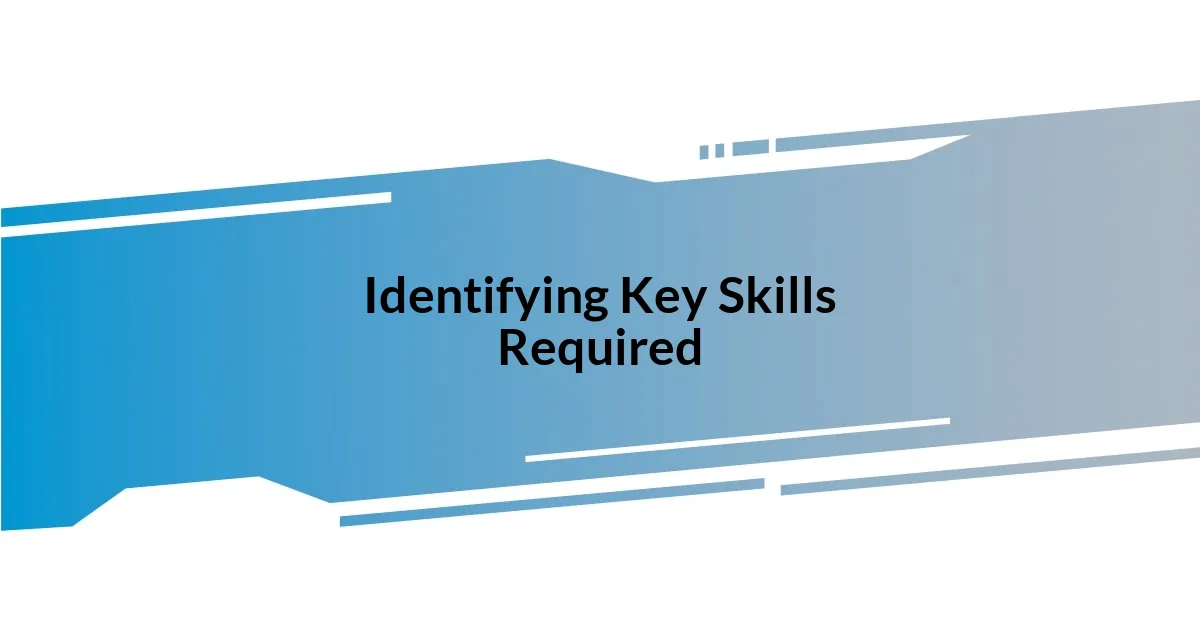Key takeaways:
- Understanding job descriptions involves breaking down skills and responsibilities to align personal experiences with company culture.
- Effectively tailor your resume by highlighting specific achievements and using action verbs to convey impact, making it relevant to the job requirements.
- Incorporating a strong summary statement can create a powerful first impression, emphasizing core competencies and personal values.
- Thoroughly review and edit your resume, including reading it aloud and seeking feedback from others to catch errors and improve clarity.

Understanding Job Descriptions
When I first started applying for jobs, I struggled to find the exact meaning behind various job descriptions. It felt overwhelming, like trying to decode a secret language that only certain professionals understood. I often wondered, “What are they really looking for?” This curiosity pushed me to break down each section of the job descriptions, leading me to uncover key requirements and responsibilities that resonated with my experiences.
One thing I’ve learned is that job descriptions often reflect not just the skills required but also the company culture. During my search, I found descriptions that emphasized teamwork and collaboration, which stood out to me. This made me think about my own experiences working in diverse teams, where we celebrated each other’s strengths. I realized that showcasing those experiences in my resume would highlight my alignment with the company’s values.
As I analyzed these descriptions, I began to recognize patterns. For instance, certain keywords would pop up frequently. “Results-driven,” “detail-oriented,” and “proactive” became standard descriptors. I remember crafting my resume to mirror these phrases, ensuring that my qualifications aligned seamlessly with what employers expected. This strategy not only helped me stand out but also made me feel more confident in my narrative when applying for positions.

Identifying Key Skills Required
Identifying key skills in job descriptions can be a bit like piecing together a puzzle. During one of my early job applications, I noticed that a particular ad kept mentioning “strong communication skills.” That phrase struck a chord with me because I had spent years refining my ability to present ideas clearly, whether in reports or during team meetings. It made me realize the importance of directly linking my experiences to these highlighted skills in my resume, almost as if I was having a conversation with my potential employer right on the page.
To efficiently pinpoint these essential skills, I recommend doing the following:
-
Highlight Repeated Keywords: Pay attention to skills that recur across various descriptions. This often signals high demand.
-
Match with Your Experience: Relate these skills to your own past work or personal experiences. Reflect on moments where these skills led to success.
-
Create a Skills Inventory: Make a list of all relevant skills you possess that align with those in the job descriptions. This helps in easily updating your resume for different applications.
-
Research Industry Standards: Look into industry-specific resources or forums to see what skills are trending within your desired field.
By focusing on these strategies, I found that I not only targeted my resume better but also became more attuned to what employers were truly looking for.

Tailoring Your Resume Content
Tailoring your resume content is crucial for making a memorable impact. I remember a time when I applied for a marketing role that specified a need for “creative problem-solving.” This phrase caught my attention because I had a project in my past where I turned a failing campaign into a success through innovative thinking. I tailored my resume to highlight that experience, showcasing not only the problem but the strategy I employed and the results achieved. This connection helped create a narrative that resonated with the job description.
Each job application is unique, and so should your resume be. For example, when I was targeting tech startups, I noticed that emphasizing my adaptability was essential. I recounted an experience where I had to quickly learn a new coding language under pressure. By tailoring my resume to reflect this adaptability alongside specific achievements, I ensured that I spoke directly to the company’s dynamic environment. It’s about presenting yourself as the perfect fit for their needs.
As I refined my resume, I created a comparison table to visualize how aligning your resume to different job descriptions can shift your focus. It’s a simple but powerful tool that showcases how minor tweaks can lead to better job matches.
| Job Description Focus | Tailored Resume Highlight |
|---|---|
| Creative Problem-Solving | Success story of campaign turnaround |
| Adaptability in Tech | Experience learning coding under pressure |

Using Action Verbs Effectively
Using action verbs effectively can transform your resume from mundane to captivating. I learned this lesson during a particularly challenging job hunt. Instead of saying I “worked on” a project, I switched to “spearheaded” to convey leadership and initiative. The difference was striking; action verbs created a vivid image of my contributions and made my experiences more compelling to employers.
When choosing action verbs, I always aim to find those that align closely with the role I’m applying for. For example, in one application, I described how I “streamlined” processes, which showcased my efficiency rather than just my involvement. It made me ask myself: Am I truly showcasing the impact I made, or am I just listing my responsibilities? This shift in perspective helped me better demonstrate my value and set myself apart from other candidates.
I often advise job seekers to build a personal library of strong action verbs relevant to their industry. This could range from “orchestrated” for project management roles to “cultivated” in client-facing positions. The process of selecting the right verb can take some time, but it’s rewarding. It not only boosts your confidence while crafting your resume but also ensures the reader feels the energy and initiative behind your experiences.

Showcasing Relevant Experience
When it comes to showcasing relevant experience, I firmly believe specificity is key. I recall applying for a customer service position, where the listing emphasized the importance of conflict resolution skills. Instead of a generic description, I shared a particular instance where I successfully de-escalated a volatile situation with a frustrated customer. This not only illustrated my ability to handle challenging interactions but also directly tied into the employer’s needs. Have you ever thought about how specific examples could make your resume resonate more?
Another strategy I’ve found effective is to align my relevant experience closely with the job requirements. For instance, I was excited about a role that sought candidates with a strong sales background. Instead of recounting my entire work history, I focused on a previous sales project where I exceeded targets by 40%. This measurable achievement stood out, showing potential employers the tangible impact of my efforts. Think about it: don’t numbers speak louder than words?
Lastly, I like to weave in personal anecdotes that reflect my journey. For one application, I shared how volunteering at a local non-profit helped hone my leadership skills while managing a team of volunteers. This not only demonstrated my initiative but added a personal touch that made my application memorable. It’s those human experiences that often connect with hiring managers beyond just the skills listed on paper. How does your own narrative play a role in your resume?

Crafting a Strong Summary Statement
Crafting a strong summary statement is like the opening act of a great concert; it sets the tone and hooks the audience. When I landed my first big job, I realized how crucial that brief overview was. I used my summary to highlight my core competencies and passions, emphasizing my commitment to continuous learning and collaboration. The result? It painted a compelling picture of who I was before potential employers even dove into my work history.
I often encourage job seekers to think of their summary as a personal elevator pitch. For instance, in my own experience, I crafted a summary that focused on my adaptability and creativity. I mentioned a time when I pivoted a marketing strategy in response to shifting market trends, demonstrating my quick thinking. Isn’t it fascinating how a few well-chosen lines can convey not just skills but personality too?
Moreover, I’ve learned that incorporating a personal touch can make your summary resonate even more. I once wrote about my passion for mentoring others, which not only showcased my leadership ability but also reflected my values. Think about what truly motivates you: how can that insight be infused into your summary to create a deeper connection with hiring managers? This approach has always helped me stand out in a crowded job market.

Reviewing and Editing Your Resume
Reviewing and editing your resume is an essential step that I never underestimate. I remember the time I thought my resume was flawless, only to discover multiple spelling errors right before submitting it. That moment taught me the importance of meticulous reviews. It’s amazing how even small oversights can change the impression you leave on potential employers. Have you ever felt that sinking feeling after realizing you missed something that could have been easily fixed?
A solid practice I recommend is reading your resume aloud. This was a game-changer for me; it helped pace my thought process and catch awkward phrases I might have missed otherwise. For instance, when I read through mine prior to a big interview, I discovered that one bullet point sounded like jargon rather than a clear accomplishment. Adjusting it made my experience more relatable and memorable. Isn’t it interesting how our perspective shifts when we vocalize our thoughts?
Lastly, I firmly believe in seeking feedback from others. Upon sharing my resume with a friend, I was surprised by their fresh insights—particularly about how I had presented my most recent role. Their perspective gave me the chance to revamp that section, ultimately making it stronger. Have you considered who in your network could offer valuable feedback? Sometimes, an outside view can illuminate aspects we might overlook ourselves.
